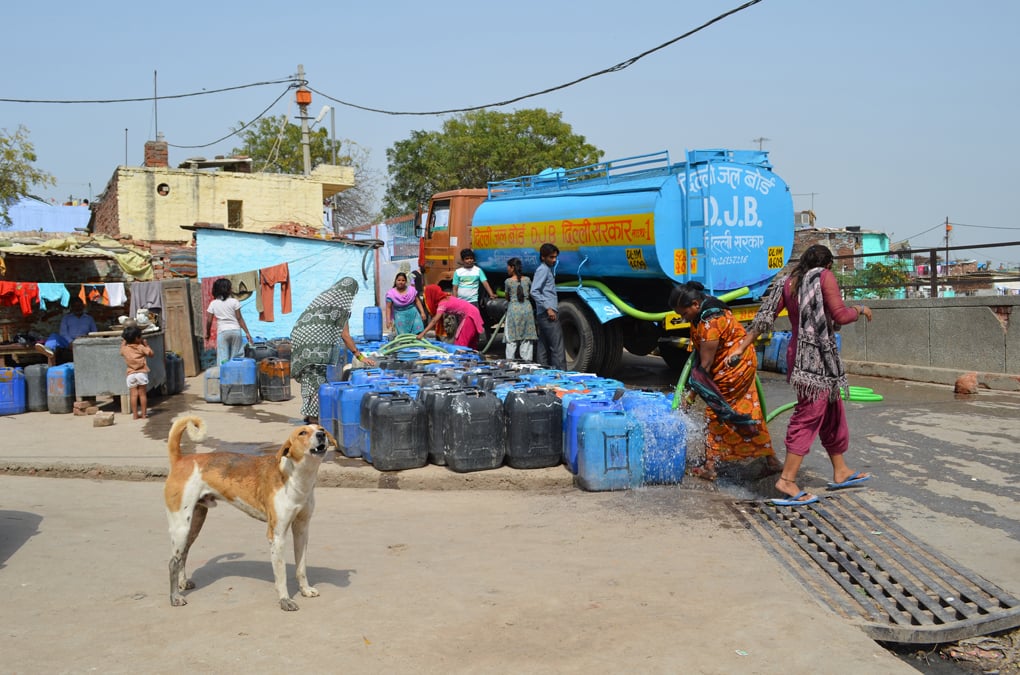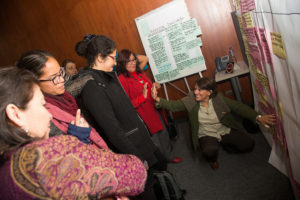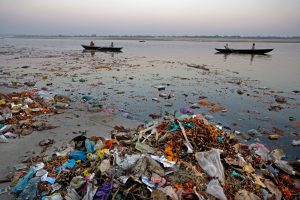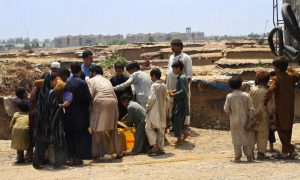Gohar Asif grapples daily with multiple water crises in his home in Jamia Nagar, a crowded colony that has come up virtually on the Yamuna riverbed in India’s national capital New Delhi. Water is not just scarce but also of an unpalatable yellow hue and highly turbid. The colony, he explains, does not get water from the government-run Delhi Jal Board (DJB) and people then extract water from the river through a bore-well. “The water is not even fit for bathing or washing clothes. The bucket itself turns yellow in four days,” Asif told thethirdpole.net.
In August last year, a worried Asif got the water tested and found that total dissolved solids (TDS) were 1,400 mg/l (milligram per litre) – 2.8 times higher than the maximum desirable limit of 500 mg/L set by the Bureau of Indian Standards (BIS).
Residents of the colony have no option but to purchase water from private vendors for drinking, cooking and even bathing. “My brother takes a bath with dirty water but purchases water to wash his head and for brushing teeth. We are buying 20-litre cans of water for Rs.20 and each family ends up spending Rs.1,200-2,000 ($20-30) per month on water,” Asif said.
Jamia Nagar in southeast Delhi is not the only colony that is suffering in this manner. Virtually every family across the sprawling city struggles with various issues related to supply and quality of water. DJB is the agency responsible for supplying water to Delhi homes, but often the water supply is erratic and taps go dry after four hours or less of water supply.
“Delhi has a shortage of water and needs to improve the water distribution, treatment and recycling system. Nearly 50% of water gets wasted due to leakages in transmission pipes,” said Vinod Jain, founder of the NGO Tapas.
Besides, as in Asif’s home, what residents get in their taps is often unsafe to drink.
In 2012, Municipal Corporation of Delhi collected 116 samples of water across the city and found that 70% of the samples were found to be contaminated with sewage due to old and cracked pipelines.
India’s teeming capital has been unable to keep pace with the growing population and its water demands. The city currently has a population of 18 million and requires 1,020 million gallons of water a day (MGD) for drinking, domestic and industrial use. But only 900 million gallons is being supplied. According to projections by Delhi Development Authority’s master plan 2021, Delhi’s population will rise to 23 million by 2020 and water demand will further go up to 1,380 MGD.
“We cannot say how much additional water Delhi will be able to provide in 2020. You can say current 900 million gallons. It will all depend on the Renuka dam and availability of water at that time,” a DJB official told thethirdpole.net.
The dam that is proposed to come up on a tributary of the Yamuna in the hill state of Himachal Pradesh is expected to provide 270 MGD to the capital city. However, the project has been delayed due to environmental and displacement concerns.
Though many in the government are pinning their hopes on the dam, Himanshu Thakkar of the NGO South Asia Network on Dams, Rivers and People is not in the favour of the project. “No, Delhi shouldn’t get more water from external sources. It is already getting its fair share of water. Instead, it needs to use its resources wisely, recycle treated sewage, reduce transmission losses, and ensure there is no wasteful use of water,” he says.
Depleting groundwater
In the meantime, the water-starved capital is relying heavily on groundwater – over 25% – resulting in severe depletion of aquifers. This is especially so in areas which do not have piped waterline or the water supply is erratic. To compound the situation, rampant construction and concretization are not allowing the groundwater to replenish, leading to a critical situation.

“There is no data available on the number of bore-wells that we have in the city. Some people do get the permission to install them but there is no data on how many extraction points we have in the city,” Sushmita Sengupta from the think tank Centre for Science and Environment pointed out.
The water table in Delhi has declined by over four metres in the last decade, according to the Ground Water Year Book 2013-2014 released by the Central Ground Water Board. The drop during 2013-14 alone was more than two metres.
“Delhi needs to take up water harvesting in a big way to augment groundwater. Plus, we are losing waterbodies which are crucial for water recharge. It is very important to have healthy water bodies for good quality groundwater,” added Sengupta.
Delhi once had nearly 900 waterbodies which acted as reservoirs and catchment areas for groundwater. But due to encroachments and concrete constructions, only 611 are left today. Out of these, 274 have dried while the rest are in poor condition.
In order to augment its water table, it is crucial that the parched capital restores and maintains its dying waterbodies. The Delhi government has said it will work towards revival of 600 waterbodies and DJB is already in the process of taking over 100 of them for the purpose. But since ownership of waterbodies lies with various agencies, acquiring all of them for rejuvenation will still be an uphill task.
Concerns for the Yamuna
Experts are also concerned that Delhi’s growing water needs are severely impacting the Yamuna, the city’s only river which is already under enormous stress and has been reduced to little more than a drain in many parts.
“You can easily see how significant Delhi’s water footprint is just by the fact that you need to dam a river (Yamuna) upstream to fulfil water requirement of a small city which has huge ecological impact. And not just this, the river gets critically polluted as it passes through the city, affecting people downstream,” explains Thakkar.
Yamuna, which is the lifeline of Delhi and provides 70% of the city’s water, is also among the world’s most polluted rivers. It literally turns into a toxic sewage drain during its 22 kilometre journey through the city with 21 drains emptying 850 million gallons of sewage into the river every day. And though Delhi has 33 operational sewage treatment plants (STPs) which can treat 640 MGD of sewage, only 390 MGD of sewage gets treated.
“The problem is that sewage is not even reaching the treatment plants. The drains carrying sewage need to be intercepted so that they don’t empty directly into the river,” said Manoj Misra, convener of the NGO Yamuna Jiye Abhiyaan.
An estimated Rs.1,500 crore (US$230 million) have been spent in cleaning the Yamuna but the river continues to be severely polluted. Seeing this, on May 8 this year, the National Green Tribunal (NGT), India’s green court, imposed a monthly tax on every household in Delhi to pay for the clean-up of the river. The money will be used to set up new sewerage treatment plants. The court was hearing a petition filed by Misra.
The tribunal has also constituted a committee to implement the Maili se Nirmal (from polluted to clean) Yamuna Revitalization Plan, 2017. Several steps have been suggested such as the mandatory recycling of treated sewage water and using it for industrial purposes, constructions, parks and the like instead of drawing fresh water – like Asif and his neighbours do in Jamia Nagar – so that the minimum ecological flow of the river is maintained.
Rejuvenating the river
While the judiciary has brought some hope for the river so has the new Aam Aadmi Party-led Delhi government, that won elections on the plank of ‘water’ issues and seems to be serious about rejuvenating the river.
Delhi’s Water Minister Kapil Mishra who himself was a campaigner to save the Yamuna before he turned politician has vowed to clean the river in three years.
“The river had no hope so far because there was lack of political will. According to our plan, we will manage to stop 70-80% of sewage from falling into the river directly in the next two years. Also, various sections of river are under different agencies because of which no one was taking the responsibility. So a SPV (special purpose vehicle) body will be set up so that the whole river stretch comes under one agency,” Mishra told thethirdpole.net.
The minister recently took a team of DJB, water activists and others on a boat ride in the Yamuna as part of a fact-finding survey to take stock of the pollution problem in the river. Water samples collected at various points reconfirmed that the river is in critical condition.
The government is planning to setup 15 new sewerage treatment plans by 2017.
“Both judiciary and the government are favourable now, especially Kapil Mishra. Certainly, the river can be cleaned. So far we lacked political will,” said activist Manoj Misra.







